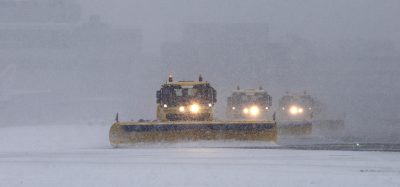Winter in Toronto
- Like
- Digg
- Del
- Tumblr
- VKontakte
- Buffer
- Love This
- Odnoklassniki
- Meneame
- Blogger
- Amazon
- Yahoo Mail
- Gmail
- AOL
- Newsvine
- HackerNews
- Evernote
- MySpace
- Mail.ru
- Viadeo
- Line
- Comments
- Yummly
- SMS
- Viber
- Telegram
- Subscribe
- Skype
- Facebook Messenger
- Kakao
- LiveJournal
- Yammer
- Edgar
- Fintel
- Mix
- Instapaper
- Copy Link
Posted: 16 September 2005 | Eric Tolton, Director of Operations, Greater Toronto Airports Authority | No comments yet
Dealing with the cold and snow has recently received an upheaval at Toronto Pearson and in this article Eric Tolton reveals some of the new methods.
Dealing with the cold and snow has recently received an upheaval at Toronto Pearson and in this article Eric Tolton reveals some of the new methods.
Unimpeded access to and from Toronto Pearson International Airport is a requirement for millions of people each year. Snow clearance, snow removal and ice control operations are some of the most critical and costly components of operating the airport. The areas requiring snow clearance and removal are in excess of 2,500,000 square metres – the equivalent of four hundred kilometres of two-lane highway.
Since the Greater Toronto Airports Authority (GTAA) assumed responsibility for the management, operation and maintenance of Toronto Pearson from the federal government in 1996, the airport has undergone a substantial physical transformation. A comprehensive redevelopment program was initiated by the GTAA to aid the fulfilment of its mandate and to allow Toronto Pearson to keep pace with the rapidly growing travel needs of southern Ontario. The Airport Development Program (ADP) is a 10-year, $4.4 billion plan that includes four major aspects: Terminal Development, Airside Development, Infield Development and Utilities and Airport Support.
Equipment for seamless storms
To ensure that the new, expanded facilities were able to function effectively during Toronto’s winter weather, it was imperative that the entire plan of winter operations be restructured. The GTAA’s goal was to minimise the inconvenience to passengers during a storm. The customer’s journey through the facilities should be as seamless and uneventful as possible.
Toronto Pearson typically experiences measurable snowfall 46 days per year and receives snowfall in excess of 5 cm, 7 times per year. The average annual snowfall is 115cm. This type of weather, coupled with passenger traffic in excess of 28 million, requires a winter operations program that mitigates the impact of weather on the overall operation of the airport.
The winter operations program at Toronto Pearson has evolved dramatically over the past several years. The runway occupancy time of the maintenance crews has dropped from an average in excess of 120 minutes to an annual average of less than 15 minutes. A circuit of the field, which includes snow removal, chemical application and inspection of all five runways and the associated high speed exits, is usually achieved in less than an hour.
At smaller airports, equipment decisions are made on the basis of finding one machine that can do all tasks reasonably well. It was identified that, owing to the size and complexity of the operation, there wouldn’t be a ‘one-size fits all’ solution to equipment needs at Toronto Pearson. The operation necessitated procuring equipment that could handle specialised tasks.
As a result of this approach, the GTAA now has a fleet that is composed of specialised equipment dedicated to each of the following tasks: runway cleaning, high-speed taxiway exits, taxiways, aprons and airside roads.
Although this means that there are many different brands and types of equipment to operate and maintain, Toronto Pearson has standardised the equipment within each of the categories to minimise the impact on operator training, mechanic training and parts procurement and warehousing.
Intensive training
Staffing requirements also increased to keep pace with the growth of the mobile fleet. An intensive 30-day training program was therefore developed. When successfully completed it qualifies recruits to drive anywhere on the airfield and to operate multi-function equipment (plow/sweeper/blower) in the runway environment. The program has a very high success ratio and is invaluable for staff operating high-tech equipment on a busy and complex airfield. It has also been a considerable factor in reducing equipment downtime, because less damage is occurring.
As the training program developed, it became apparent that there were two major obstacles that had to be overcome to ensure the effectiveness of the winter operations program. One pertained to runway orientation and the other to runway intersections. The runway configuration at Toronto Pearson includes three east-west parallels and two north-south parallels. Both of the north-south runways intersect the northern east-west runway. Although significant inroads into our runway occupancy time were made, analysis found that more time was often spent waiting for clearance through an intersection than was spent on actual snow removal.
During a typical winter storm, the winds put the operation on the east-west runways. After the cold front passes through, there is a significant wind shift that results in a runway change. Having spent most of the time during the storm concentrating on keeping the east-west runways open, there were occasions when the north-south runways were not fully prepared for operation when the wind shift occurred.
A circuit solution
After numerous brain-storming sessions, the concept of an airfield circuit emerged. A pattern was created whereby all five runways were sequentially cleared in the same manner regardless of the circumstances. The only variation comes in the starting point, which is based on the active runways being easterly or westerly oriented.
It was necessary to choreograph the movement of the runway team, the high speed exit team, the chemical applicators and inspection vehicles in such a way that there would always be two east-west runways available for use. As a result of the synchronisation, the runway occupancy time for any given runway was minimised, as was the overall time to complete a circuit.
The simplicity and consistency of the circuit has had many benefits. Air Traffic Control (ATC) can anticipate when a runway will be returned to service, which allows them to minimise the time lag between the last vehicle vacating a runway and the first aircraft touching down on the freshly cleaned surface. Aircraft and vehicle traffic patterns can also be anticipated an hour in advance.
Clearer communications
A successful operation is one that has been well co-ordinated and communicated. To ensure optimum communication between members of the Core Planning Group the GTAA implemented a hotline. The Core Planning Group is made up of the Shift Manager from the Area Control Centre (ACC), the Tower Supervisor (ATC), the Snow Desk (Airport Duty Manager) and the Maintenance Manager (Airfield Maintenance Facility Command Centre). All decisions regarding the timing and routing of snow removal activities are agreed upon by all parties and then the information is disseminated to all other groups (Central Deicing Facility, Apron Management Unit, Snow Removal Crews etc).
In an effort to keep all parties current with airport conditions and activities, regular conference calls are held. Every morning, Nav Canada (Air Traffic Control) hosts a conference call to review the weather, planned closures and the anticipated operation for the next 24 hours.
Throughout the winter season, the GTAA also hosts an evening call. The weather is reviewed, as is a description of the state of readiness of the Central Deicing Facility and the maintenance crews. In the event of pending storms, the forecast and its anticipated impact on operations are discussed. Ad hoc conference calls are also held during the storm to keep all parties abreast of the changeable conditions.
The planning group’s discussions concerning launch capacity during the conference calls will trigger the air carriers to thin their schedules by either cancelling or consolidating flights. Ideally, the air carriers will make these decisions the night before the storm, in order to be able to contact passengers and advise them of changes to their flight.
As a further enhancement to the communication process, the GTAA has also developed an ‘Irregular Operations’ website. The website was launched last winter and provides the airport community with current information on weather, airfield configuration and capacity, as well as the status of the Central Deicing Facility.
Working together
The GTAA formed the Airside Ground Operations Working Group in 1997. The group is composed of representatives from the GTAA, air carriers, ground handlers and Nav Canada. Its purpose is to identify issues, research solutions and provide recommendations to continually improve the efficiency of the operation.
Although it deals with all types of issues, ranging from lightning detection systems to preparations for the Airbus A380 aircraft, its major focus has so far been winter operations. The group meets regularly throughout the year, as do its many sub-committees and working groups. The co-operative and collaborative nature of the group has fostered an overall team approach to continuous improvement.
Another forum that has been created is the Weather Response Team. This group is composed of senior level management of the GTAA, Nav Canada and representative air carriers and ground handlers. It is an open forum where every participant is asked to provide an evaluation of a past storm, how it impacted on their operations and also to offer constructive suggestions on how to improve activities for the next event. The discussions are focused on future improvement, not assignment of blame.
Minimising the inconvenience to passengers during winter storms is a priority to the GTAA. Its approach to winter operations takes into consideration safety, environmental factors and the combined effect of major air carriers’ hub operations. Through the implementation of the Core Planning Group hotline, regular conference calls, the Airside Ground Operations Working Group, the Weather Response Team and strategic equipment and resource planning, winter operations are well co-ordinated and communicated. The results are self-evident. The ability to consistently clean five runways in approximately one hour allows the air carriers to maintain a reduced, but predictable operation. This plan accommodates the needs of the travelling public, without compromising safety. Furthermore as Toronto Pearson continues to expand and evolve, so does its winter operations program.
Eric Tolton
Eric Tolton is currently the Director of Operations for the Greater Toronto Airports Authority and is also the Vice-Chair of the International Association of Airport Executives – Canada. Throughout his twenty-five years in aviation Eric has worked as a Flight Service Specialist and as a Station Manager at airports in the Yukon and Northwest Territories. He then switched to Airport Operations and moved to Yellowknife. He has served as the Airport Manager in Fort McMurray, Alberta and Fort St. John, British Columbia before moving to Toronto, Ontario.

















